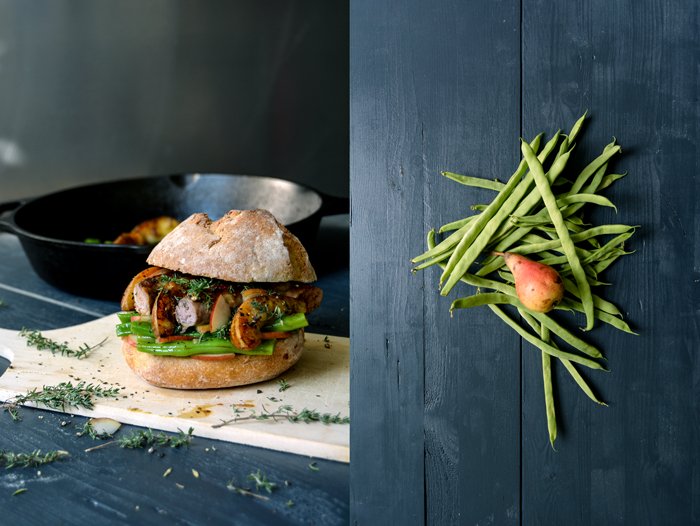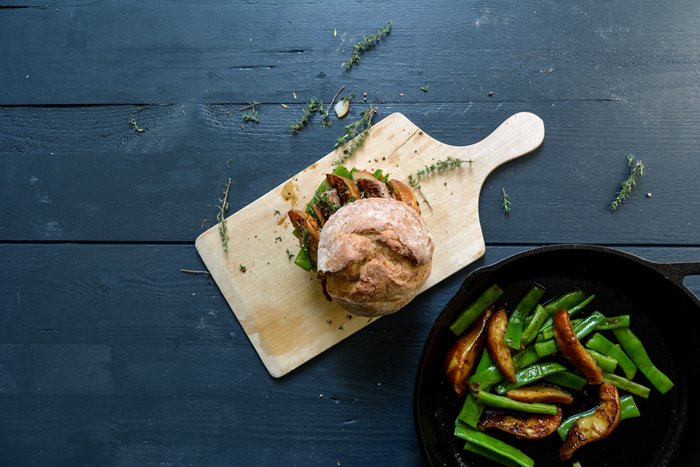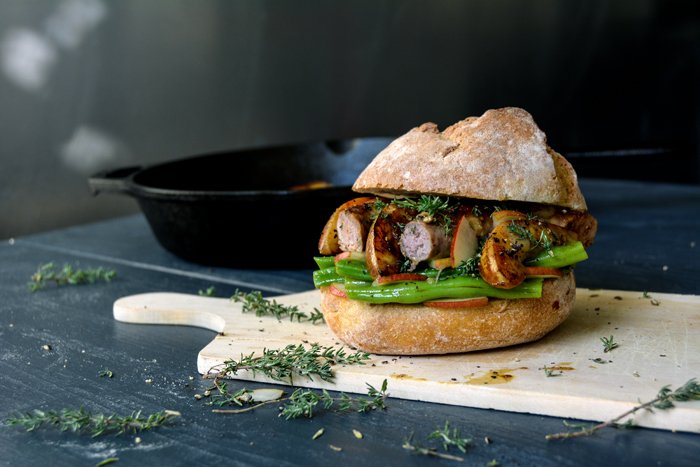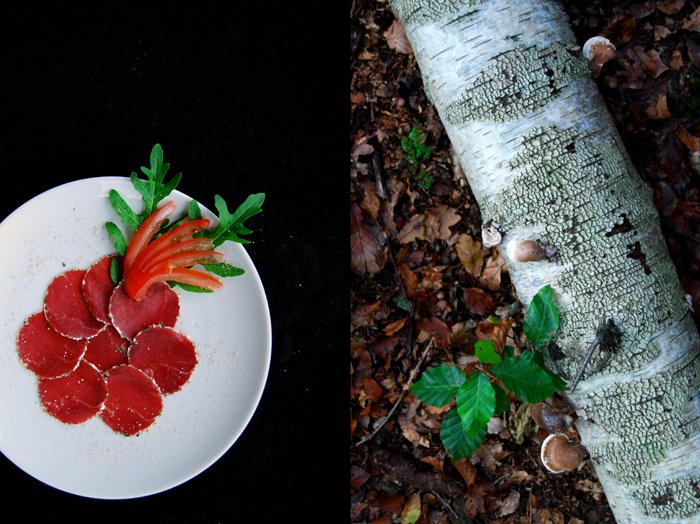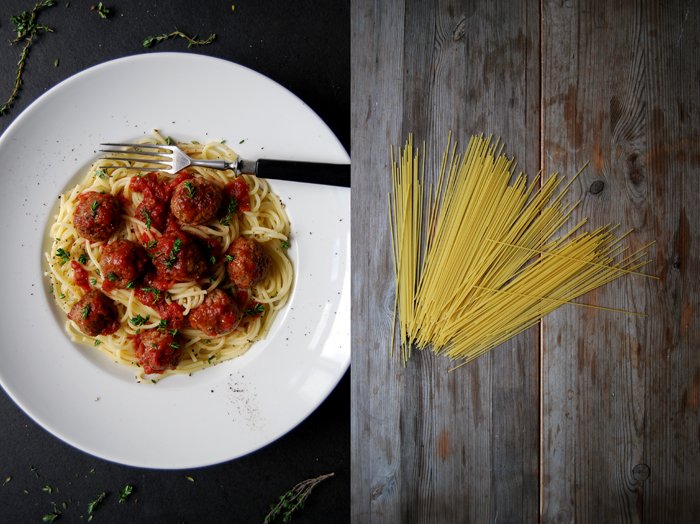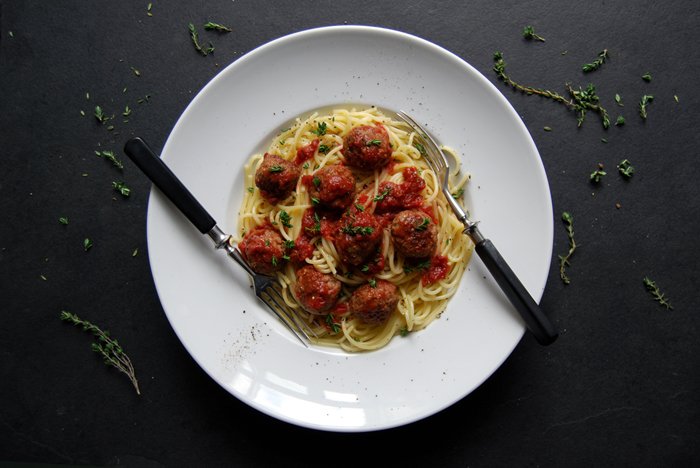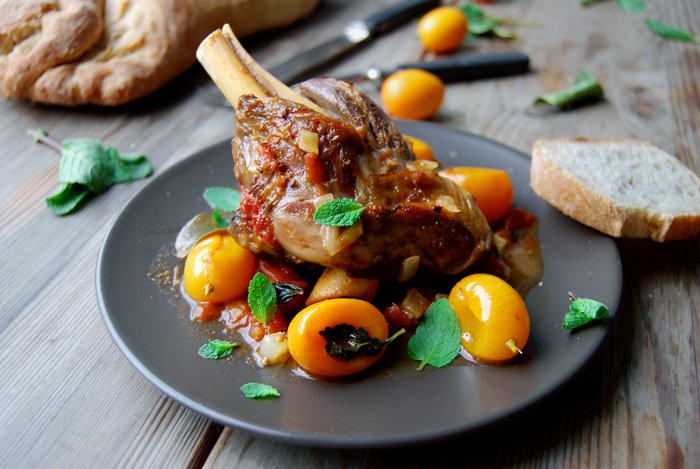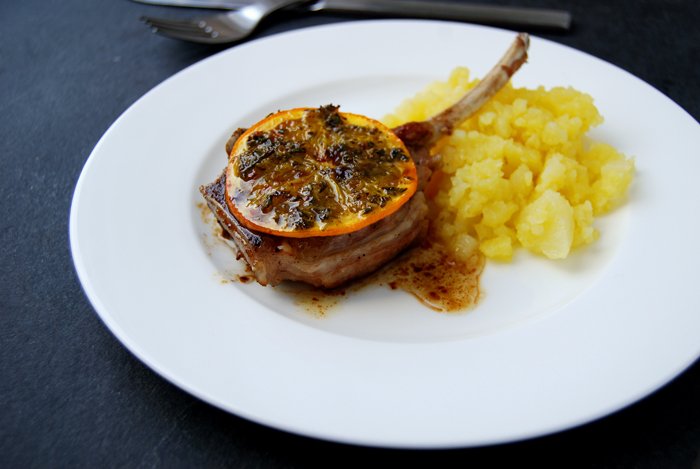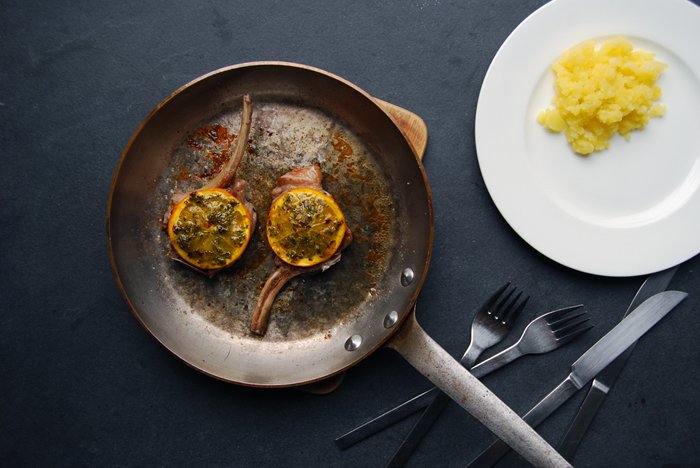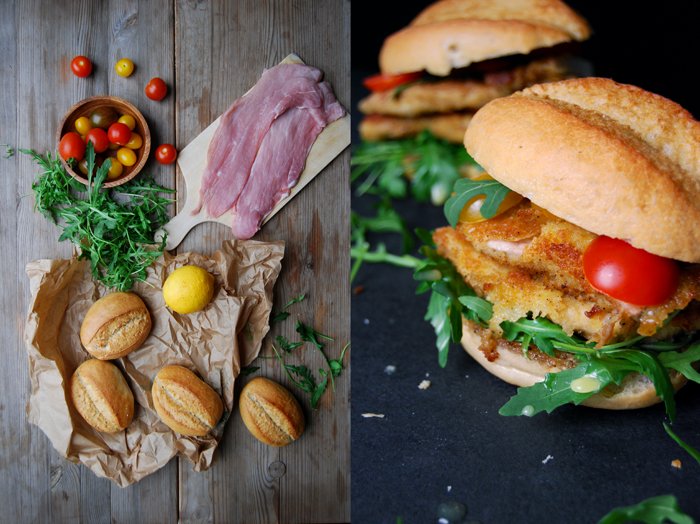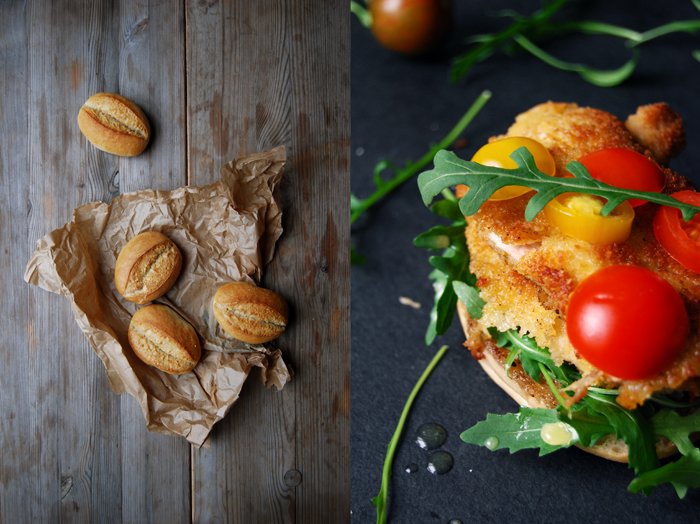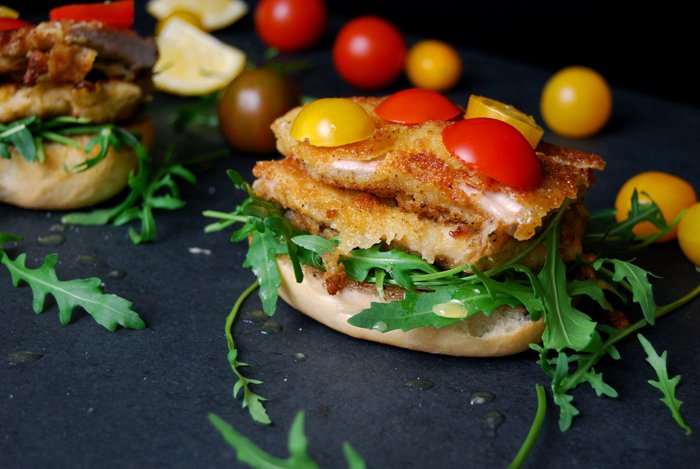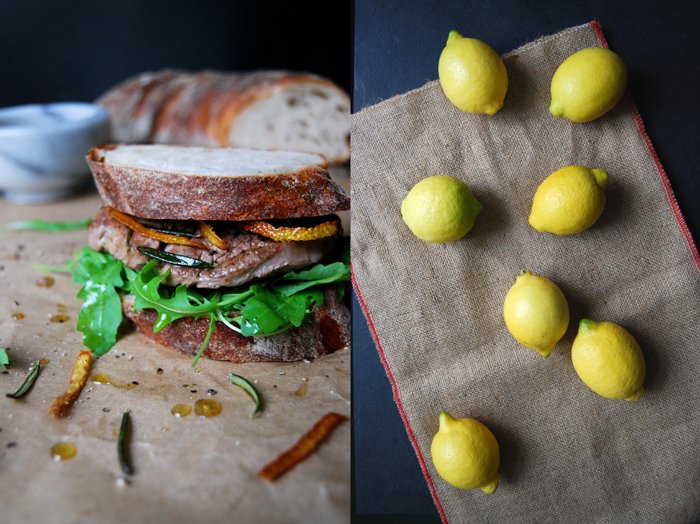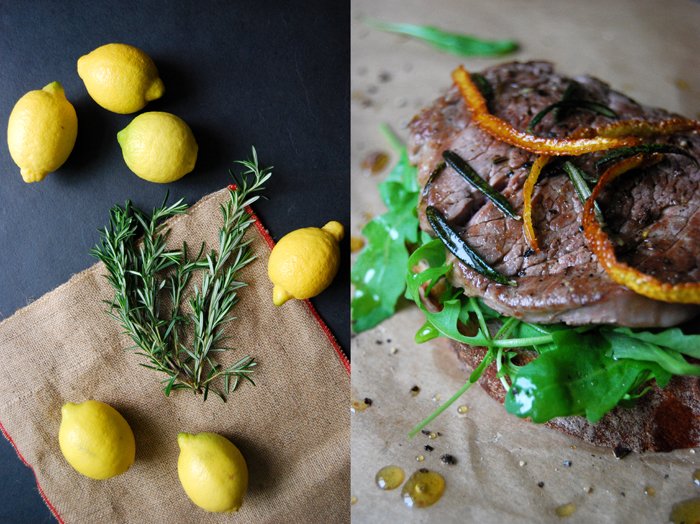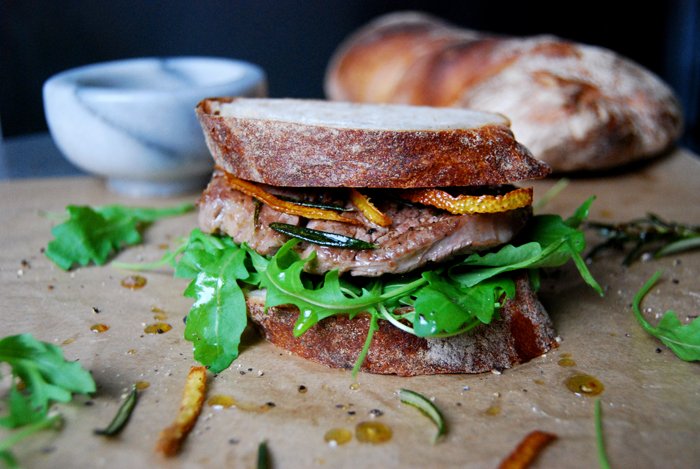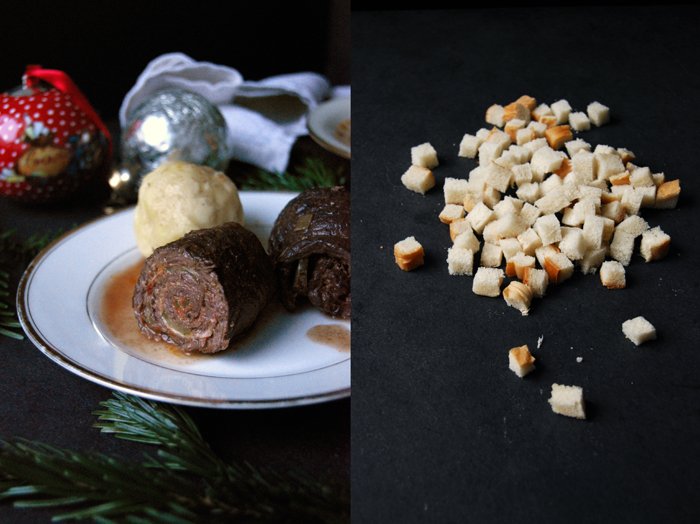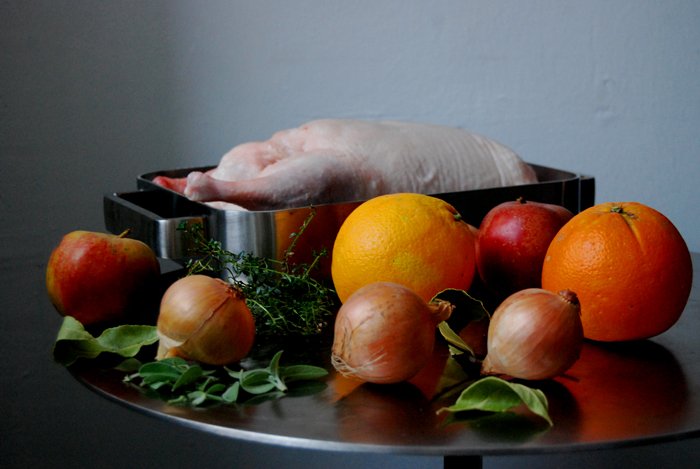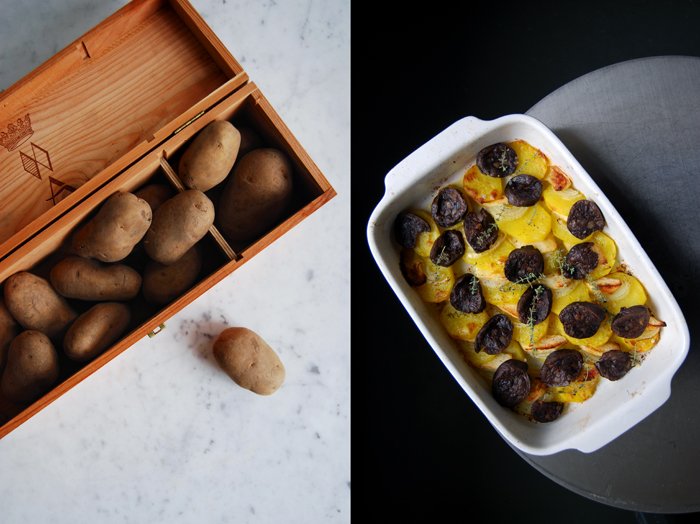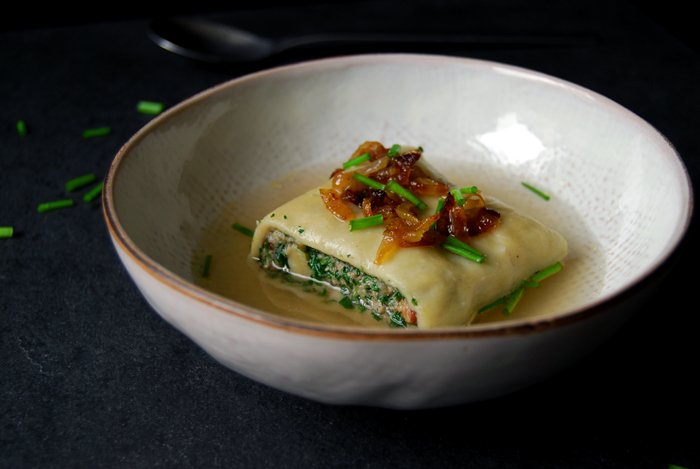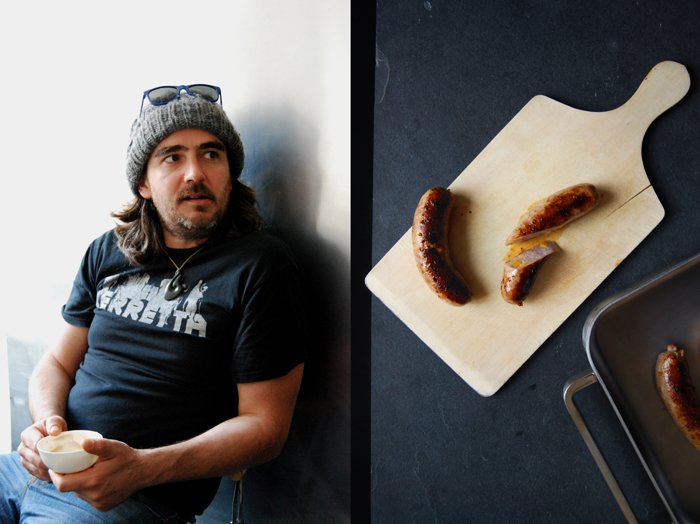Green Bean and Sausage Sandwich with Pear Mustard and Thyme
A bag full of green beans and a handful of overly ripe pears called for an urgent recipe. In the end, it became a sandwich, almost everything works in a sandwich, but if you prefer, you could easily leave out the bun and go for a proper lunch or dinner.
Crisp green beans, sautéed until just al dente, pair deliciously well with hearty herb sausage and honey-sweet pears. I cook the fruit in the sausages' concentrated frying juices until golden and soft, but still in shape. A part of them goes on top of the beans snuggled in next to the meat but the rest is turned into a spicy and aromatic fruit mustard - it's so good, you can also use it for steak, roasts and burgers. I'm absolutely hooked on it! The ratio has to be balanced, lots of pear stand up confidently against a teaspoon of fine Dijon mustard. It's more of a mustardy sauce than a thick dip, fruity and rich. And don't expect a beauty, it comes in a rather pale beige but the taste totally makes up for it.
Green Bean and Sausage Sandwich with Pear Mustard and Thyme
Serves 2 (as sandwiches, or without the buns, as a warm one pan dish)
buns, cut in half, 2
green beans, the ends snipped off, 160g / 5 1/2 ounces (use 300g / 10 1/2 ounces beans if you serve them without the bun)
olive oil
fine sea salt
ground pepper
herbed sausages 2
pears, rinsed (not peeled), cored, cut into slim wedges, 2
Dijon mustard 1 teaspoon
For the topping
fresh thyme leaves 1-2 teaspoons
black peppercorns, crushed in a mortar
In a large pot, blanche the beans for a few minutes in salted water until al dente, drain and rinse quickly with cold water. Transfer back to the pot, stir in a splash of olive oil and season with salt and pepper.
Heat a splash of olive oil in a heavy pan and cook the sausages on medium heat for about 10 minutes until golden brown. Take the meat out of the pan and set aside, add the pear wedges (leave 2 wedges out on a plate) and sauté for about 1 minute on each side until golden brown, set the pan aside. Transfer about 100g / 3 1/2 ounces of the cooked pear into a blender, add the mustard and purée until smooth. Season with salt, pepper and mustard to taste and set aside. If you want to serve it as a warm pan dish stop here, add the sausages and beans to the pan and serve with the pear mustard sauce and thyme.
For the sandwich, cut the remaining uncooked pear wedges into slim slices. Brush the soft inside of the buns with the juices from the pan and lay the beans and uncooked, sliced pear on top. Divide the sausage and cooked pear wedges between the buns and sprinkle with crushed pepper and thyme. Finish it off with luscious dollops of the pear mustard, close the bun and enjoy.
Spicy Roast Beef and Rhubarb Chutney Sandwich
Amazing news: eat in my kitchen is Yahoo Food's 'Blogger of the Week'!! Click here to take a peek in my kitchen and read the interview with the wonderful Rachel Tepper about sweets and plans in life!
Distracted by this excitement, I felt a bit indecisive in the kitchen, an unusual state of mind for me especially when it's about my Sandwich Wednesdays. To come up with a yummy new creation between two slices of bread every week has been one of the easier tasks since I started eat in my kitchen.
Sandwich recipes come to me quite easily, luckily, I don't have to think much about it. And it would have been the same this week if I hadn't gotten the stubborn idea stuck in my head that I wanted to empty an open jar of my spicy rhubarb chutney (amongst a few other jars) and use it for a sandwich. I was hardheaded and that always blocks my creativity. Soon we'll be in Malta and our apartment will be in the hands of a trusted friend while we're away, including our fridge which I'm aiming to empty completely and to have in a sparkly and spotless state by the day of our departure.
So, the chutney had to go and a sandwich had to be made. Pastrami seemed perfect but the quality at the store didn't convince me. When I spotted roast beef, freshly cut, bright pink on the inside with a spiced crust my chutney sandwich was saved. Still at the market, I threw some fresh chili peppers and a rustic French loaf into the basket and off I went. The first bite confirmed my suspicions, the beef and spicy rhubarb are a match made in heaven!
This recipe has been featured by Food52, you find my rhubarb chutney recipe here!
Spicy Roast Beef and Rhubarb Chutney Sandwich
For 2 sandwiches you need
rustic white bread 4 slices
roast beef, thinly cut, 8 slices
rhubarb chutney (or any other fruity chutney) 2-4 teaspoons, to taste
rucola leaves (arugula), a small handful
fresh red chili pepper, without seeds and thinly sliced, 1/2
black peppercorns, crushed in a mortar
olive oil, for the bread
Brush the bottom slice of bread with a little olive oil, arrange the rucola and roast beef on top and sprinkle with chutney, chili pepper and crushed pepper. Close your sandwich and enjoy!
Fennel Burger and Elderflower Onion Sandwich with Gruyère
If two passionate cooks are in a relationship you need a well thought-out kitchen plan. My boyfriend and I have a great passion for cooking, we love to experiment with recipes and ingredients but it just doesn't work at the same time. A cook is a leader and therefore needs total command in the kitchen to guarantee successful results. So many, many years ago we made a wise decision: depending on the recipe, one of us takes over control and has the last word when it comes to the important decisions, and the other one just assists. It works perfectly, no discussions and no arguments as long as we stick to the plan and don't get in each other's way.
Luckily, we love the same cuisine, Mediterranean and North European comfort dishes. The preparations are always quite relaxed and most of the time very satisfying at table. While chopping and cooking, there is often wine, cheese and olives involved to nibble and chill, I've mentioned it so often, it's definitely my favourite way to end a day. However, life would be boring, if two people had the same approach in the kitchen and we're definitely two absolutely different personalities. We find inspiration in different ingredients, flavours and combinations. My man likes it a bit more crazy, wild and experimental when he takes over the kitchen. He often combines flavours which seem too far apart to my mind, but the results are delicious and that's what counts.
A few days ago he came up with the genius idea to deglaze onions with elderflower syrup, it was fantastic! And to make it even better, he placed them on top of juicy fennel burgers. So, you need to know, when he uses our fennel seeds from Malta, he measures them by the tablespoon and not the teaspoon, the aroma is strong and present in this recipe and pure bliss in combination with the elderflower onion's smoky sweetness. There was also a thin layer of melted Gruyère cheese in between and at that point I knew I would have to share this recipe with you! I loved it!
Fennel Burger and Elderflower Onion Sandwich with Gruyère
For 8 burgers (or 4 hungry people) you need
For the sandwiches
medium onions, cut in half and thinly sliced, 3-4
butter 1-2 tablespoons
elderflower syrup, about 6 teaspoons, to taste
salt and pepper
rustic white buns, cut in half, 8
crisp lettuce, 8-16 small leaves
Gruyère cheese, 8-16 slices
For the burgers
minced beef 1 kg / 2 1/4 pounds
dry breadcrumbs 80g / 1/2 cup / 3oz
organic eggs 2
garlic, crushed, 2 cloves
fennel seeds, crushed in a mortar, 2 tablespoons
salt 3 teaspoons
pepper
butter 1-2 tablespoons
olive oil
Start with the onions and fry the burgers at the end, you want them to be hot enough to melt the cheese.
In a heavy pan, heat 1 tablespoon of butter and fry the onions for about 10-15 minutes until golden brown and soft. Add more butter if they dry out. When they are done, turn up the heat and deglaze with a splash of elderflower syrup. Season with salt and pepper to taste, take off the heat and set the pan aside.
Mix the ingredients for the burgers in a large bowl (with your hands or the hooks of an electric mixer) and form 8 thick burgers with wet hands. Heat a generous splash of olive oil and a tablespoon of butter in a heavy pan and fry the burgers on medium-high heat for 1 minute on each side, turn down the heat to medium-low and continue frying until they are golden brown, add more butter if necessary. The cooking time depends on how well done you like them, cut a burger in half to check the inside. Once they are done, lay 1-2 slices of cheese on top of each warm burger immediately.
Arrange 1-2 slices of lettuce on the bottom half of each bun, lay the burgers with the cheese on top and finish with the onions. Close the buns and enjoy!
Thyme and Lemon Ricotta stuffed Pork Roll
This scrumptious pork roll combines the hearty qualities of a juicy roast topped with crunchy crackling and the fresh spring feeling of ricotta, lemon zest, parmesan and thyme. If you liked my Bavarian Beer Roast for those cosy dinners at winter time, this is a great alternative for the warmer season, for a summery Sunday lunch under the bright blue sky and blossoming trees. It's the perfect recipe to feast with your friends, the table filled with plates of crisp asparagus tomato salad, loaves of homemade bread and pink glasses of chilled rosé wine - and the roast right in the middle!
You could use butterflied pork loin from a fully grown pig for this dish but I went for suckling pig. Its fine flavour and tender texture is exactly what you need if you want to roll up the loin with a light Mediterranean stuffing, no distractions, just the fine aromas merged with the meat.
Suckling pig is a traditional German dish, you can often see it at village feasts in the countryside, a whole pig roast on a spit over the open grill. The scene can be a bit intimidating, it's an archaic ritual - meat and fire. To me, it's part of our nature and as I decided to include meat in my diet, I also decided to confront myself with various cooking methods, even the ones that aren't as pleasing for the eyes as a schnitzel covered in breadcrumbs.
Thyme and Lemon Ricotta stuffed Pork Roll
For 6 people you need
suckling pork loin, boneless, butterflied, 1,2kg / 2 3/4 pounds
ricotta 225g / 8 ounces
freshly squeezed lemon juice 1 tablespoon
lemon zest 1 heaping tablespoon
Parmesan 1 heaping tablespoon
fresh thyme leaves, 1 heaping tablespoon
black peppercorns, crushed in a mortar, 1 teaspoon
fine sea salt 1 teaspoon
coarse sea salt, to sprinkle the roll
cotton string for the roll
Set the oven to 240°C / 465°F (I used the Rotitherm setting).
Whisk the ricotta, lemon juice, zest, parmesan, thyme, pepper and salt. Lay the meat out flat on the kitchen top and spread with the ricotta-spice mix, leave a 2 cm / 3/4" rim all the way round. Roll up the meat tightly without squeezing out the filling and tie with a cotton string every 3cm / 1". Sprinkle the skin generously with sea salt (push it into the skin a little), place the roll in a roasting dish and roast in the oven for 10 minutes. Turn down the heat to 175°C / 350°F and roast for 35 minutes. Turn on the grill until the skin starts to crackle. Take the meat out of the oven, wrap in aluminium foil and let it rest for 10 minutes before serving. Serve with asparagus tomato salad or a light potato salad.
The meat also tastes great cold, cut into thin slices, on a sandwich!
Carpaccio di Capriolo with Herbs, Ginger, Lemon and Parmesan Crust
I forgot about this recipe completely, unfortunately, as it was divine! This isn't one of my own creations, it was made for me and my family by my cousin Thomas, a very talented young chef. It was definitely too good not to share on eat in my kitchen, so here's Thomas' Carpaccio di Capriolo, prepared and savoured by all of us in my mother's kitchen, we were thrilled!
A few months ago, in late autumn, I wrote about a special weekend at my mother's house in the countryside. My family met to eat, drink, chat and savour, as usual, but this time we had a whole deer to prepare. We got the animal from a farmer close by, he's a hunter but he also keeps deer on his vast land. My cousin Thomas who is experienced in butchering gave us more than a helping hand, he prepared the single cuts and parts to be frozen and used some for our extensive cooking. My mother cooked a heavenly stew for us and later on Thomas prepared two dishes himself, Pâté en Croûte, venison pâté in pastry crust, and one of the best carpaccio's I tasted in my whole life. He used the delicate deer's back which he had just cut, it was exceptionally good. If it's hard for you to find quality venison, especially at this time of the year, you could also prepare this recipe with beef fillet. I definitely recommend you to buy it from your trusted butcher or directly from a farmer as the meat has to be very fresh.
And here's the secret to Thomas' carpaccio: My cousin chef coated the meat in an aromatic crust of finely chopped fresh rosemary, sage and thyme mixed with ginger, lemon zest and aged Parmesan. The thin crust was far from being overpowering, just right to add its quality to the fine flavours of the meat.
I was so busy feasting this weekend that I didn't take many pictures of all the ongoing preparations in my mother's kitchen so I decided to share some of the amazingly beautiful fungi we found on our long walks in the forest. Not to be eaten but so beautiful!
Carpaccio di Capriolo with Herbs, Ginger, Lemon and Parmesan Crust
It works best to cut the carpaccio very thinly with an electric food slicer.
For 4 people you need
fresh venison fillet (or beef fillet) 300g / 10.5 ounces
mixed fresh herbs (rosemary, sage, thyme), finely chopped, 2 tablespoons
aged Parmesan, finely grated, 1 tablespoon
ginger, finely grated, 1 teaspoon
lemon zest 1 teaspoon
ground black pepper
rucola and tomato slices to serve
Mix the herbs, Parmesan, ginger and zest on a large plate and roll the meat in the mixture until evenly coated. Carefully wrap the fillet in cling film and close it like a bonbon wrapper. Keep in the freezer for at least 4 hours before you cut it very thinly with an electric food slicer. Arrange the slices on plates with the rucola and tomato and sprinkle with a little pepper, serve immediately. You could also drizzle some lemon oil over the carpaccio.
Thyme, Rosemary and Parmesan Meatballs with Pasta and Tomato Sugo
This is the essence of Italian food for me, a huge plate full of warm pasta with tiny meat balls, fruity tomato sugo and fresh thyme and rosemary. A glass of the deepest red wine, Caruso on the vinyl player and the world is as perfect as it can possible be!
I first learned to enjoy burgers through my Maltese/ American partner, he introduced these rather well sized portions of meat to my cooking. In the past, I only used to shape little balls of minced beef, lamb or pork in my kitchen, that's how I learned it from my mother and I followed her recipe for years. She mixes the meat with eggs and breadcrumbs for a fluffy texture and lots of fresh herbs from her garden before she gives them a small round shape. In general, she's not a big fan of huge portions on her plate so the dimensions of a proper burger didn't really appeal to her. This only changed in the past few years, now she tells me with excitement about rustic burger nights in her kitchen!
I can't even say which size I prefer, sometimes my appetite calls for a massive burger, preferably pure minced steak stuffed between a bun with some greens and thin tomato slices. Small meatballs are a delicious (and addictive) snack, warm and cold. They are perfect nibbles for a brunch or casual cocktail party, and absolutely tempting when it comes to pasta. Cook them in an aromatic tomato sugo, or with lots of onions and white wine, and you'll have the most comforting dish on your plate. Their size should always be small enough to fit on a fork with a bit of sugo on top, heavenly! And here my mother's recipe comes in again, I mixed the minced meat with lots of fresh thyme, rosemary and garlic to give it a rich Mediterranean touch. And not to forget grated parmesan, 3 heaped tablespoons melted into the tiny balls added the cheese's wonderful aroma to the meat. For the sugo, I used tinned tomatoes, full of summery flavour and sweetness, at this point the fresh ones aren't an option yet. I added some red wine, Balsamico vinegar, a tiny bit of fresh orange juice and chopped rosemary to end up with a concentrated red sauce full of beautiful flavours. It looked stunning and tasted just as good.
Thyme, Rosemary and Parmesan Meatballs with Pasta and Tomato Sugo
For 3-4 people you need
spaghetti 300g / 10 1/2 ounces
For the meatballs
minced beef 500g / 1 pound
organic egg 1
breadcrumbs 40g / 1 1/2 ounces
medium onion, finely chopped 1
garlic, crushed, 2 big cloves
fresh thyme leaves 2 tablespoons
fresh rosemary, finely chopped, 1 teaspoon
freshly grated Parmesan 3 heaping tablespoons
salt 1 1/2 teaspoons
pepper
olive oil, for frying
butter 2 tablespoons, for frying
For the tomato sugo
red wine 75ml/ 2 1/2 ounces
fresh thyme 1 small sprig
quality tinned tomatoes 600g / 1 1/4 pounds
balsamic vinegar 1 1/2 tablespoons, to taste
freshly squeezed orange juice 1 1/2 tablespoons, to taste
fresh rosemary, finely chopped, 1 1/2 teaspoons
salt and pepper
Cook the pasta in lots of salted water al dente.
Mix the ingredients for the meatballs with your hands or an electric mixer until well combined. Wet your hands and form walnut sized meatballs. In a large pan, heat a generous splash of olive oil and 2 tablespoons of butter and fry the meatballs for about 6 minutes on medium heat, turning them so that they can brown evenly. Take the meatballs out and set them aside, cover them with a lid. Put the pan back on the heat and deglaze with the red wine, add the thyme sprig and cook for 1 minute. Pour in the tinned tomatoes, chop them and add the balsamic vinegar, orange juice, rosemary, salt and pepper. Cook for about 5 minutes (bubbling) or until it starts to thicken and season with salt, pepper, orange juice and vinegar to taste. Add the meatballs to the sugo and cook for another minute on low heat. Serve with the spaghetti in warm plates.
Braised Lamb Shanks with Kumquat, Fennel, Cardamom and Mint
This is the most tender, aromatic and colourful braised dish you can possibly have on your plate at this time of year, at least in the Northern hemisphere. Cardamom, cumin, fennel and coriander seeds refine the deep red juices of summery (tinned) tomatoes cooked with succulent lamb shanks before tiny yellow kumquats add their bittersweet fruitiness. The fresh mint leaves on top are more than just pretty in this warming composition, their job is to freshen it up! A sheer explosions of aromas!
Over the years, I have become a big fan of shanks in my kitchen whenever I'm in the mood for a stew. Be it beef, veal or lamb, I prefer this cut over chuck steaks. The meat around the bone is packed in fat which keeps it juicy and tender while it braises in a fragrant broth of wine, fruit and vegetables. Shanks usually taste quite strong, they can easily deal with spices and herbs, perfect for Mediterranean comfort cooking with lots of rosemary, thyme, sage and garlic, or to find some inspiration in the Arabic cuisine. All those spices, those warming corns, pods and powders, cumin, turmeric, cayenne, cinnamon and many more, this is the best moment to let their qualities shine. Spices are great on their own but even better in a team. Be experimental, combine your favourites and use a little bit more than you usually would, the meat and sauce can take it!
Braised Lamb Shanks with Kumquat, Fennel, Cardamom and Mint
You need an oven proof dish / casserole dish with a lid for this recipe.
For 3-4 people you need
lamb shanks 3-4
fennel seeds, crushed in a mortar, 2 teaspoons
coriander seeds, crushed in a mortar, 1 teaspoon
ground cardamom 1 teaspoon
ground cumin 1 teaspoon
medium onion, finely chopped, 1
garlic, cut in half, 4 cloves
white wine 400ml / 1 pint
tinned tomatoes of good quality (it's worth going for a good brand!) 400g / 14 ounces
bay leaves 2
orange peel 4 long strips
kumquats, rinsed, 8
sea salt and pepper
olive oil
fresh mint leaves, a small handful
Set the oven to 160°C / 320°F.
In a casserole dish, heat a splash of olive oil and sear the shanks for a few minutes until golden brown on all sides. Take the meat out and set it aside but keep the casserole dish on the heat. Add a little more olive oil and the fennel seeds, coriander, cardamom and cumin, cook for about 20 seconds on medium heat or until you smell the spices, stir constantly. Add the onions and garlic and cook for 1-2 minutes. Mix the lamb shanks with the spices and onion and pour the wine over the meat. Season with salt and pepper. Add the orange peel, bay leaves and tomatoes, chop them roughly, mix everything and bring to a simmer. Close the casserole dish with a lid and cook in the oven for 1 1/2 hours. Add the kumquats (whole, not cut) and cook for another 30 minutes or until the meat is tender and you can lift it with a fork off the bone.
If necessary, take out the meat when it's done and cook down the sauce. Season to taste and serve with fresh mint leaves and thick slices of white bread or flatbread.
Lamb Chops with Orange-Herb Crust & Mediterranean Mashed Potatoes
When the popular German food magazine Lust auf Genuss asked to feature eat in my kitchen in their February print issue I was more than excited. This magazine is a culinary gem! Their fantastic team creates so many amazing recipes and shares detailed information about our every day ingredients. I really love their special columns about wine makers and other fascinating food producers and their delicious products, just reading through the pages and seeing the pictures makes me want to cook!
I was very lucky, this month's issue was about citrus fruits which made my pleasure even greater, there is barely a recipe without oranges, lemons or tangerines coming out of my kitchen at the moment. So a whole magazine dedicated to my beloved powerful fruits felt like the perfect surrounding for a feature about me and the blog, especially because I was asked to contribute a new recipe which wasn't on the blog yet. My first choice was guinea fowl with lemon ricotta stuffed under the skin but the magazine's own cooking team had a similar recipe in mind. Lamb chops were next on my list. Easter is close and there'll definitely be lamb on the table at one point, it also combines wonderfully with citrus flavours. It seemed just perfect. The decision for the final recipe was actually made in the forest, during an afternoon walk with my mother. We chatted about the feature and within seconds the idea was set: the chops quickly seared and topped with a thin slice of orange then finished under the grill. The orange coated in a layer of chopped, fresh herbs (rosemary, thyme and sage) mixed with parmesan and olive oil. The ripe cheese creates a fine crust in the oven and adds its wonderful aroma to the composition.
I served the lamb with lemony Mediterranean mashed potatoes to keep it pure and simple, just olive oil, sea salt and a bit of lemon zest chopped with a knife into the roots. This is the right meal to get into the mood for spring and all its culinary pleasures!
Lamb Chops with Orange Herb Crust & Mediterranean Mashed Potatoes
For 2 people you need
For the lamb chops
lamb chops (1 1/2-2cm / 3/4" thick) 6, about 450g / 16 ounces
organic orange, ends cut off, very thinly sliced, 1 (you'll need 6 slices)
olive oil 3 tablespoons plus more for frying
mixed fresh herbs (rosemary, sage, thyme), finely chopped, 1 tablespoon
freshly grated aged Parmesan 2 tablespoons
salt and pepper
Set the oven to grill (broiler), the oven has to be hot when you put the meat in.
Whisk the olive oil, herbs and Parmesan and coat 6 slices of orange generously with the herb oil on both sides. Heat a splash of olive oil in a pan and sear the lamb chops over a high heat for 1 minute on each side. I like them rare, keep them in the pan for another 30 seconds if you prefer them medium. Take the pan off the heat and season with salt and pepper. Lay 1 slice of herb coated orange on each piece of meat and put the lamb chops under the hot grill for about 1 minute (just let cheese melt and the rind turn golden brown). Serve with the mashed potatoes.
For the mashed potatoes
potatoes, peeled and cooked in salted water, about 400g / 14 ounces
olive oil 50ml / 2 ounces
lemon zest 1 1/2 teaspoons
sea salt
Chop the warm potatoes with a knife until they have a lumpy texture adding the oil constantly. Stir in the zest and season with salt.
Schnitzel Sandwich with Lemon Butter, Rucola and Cherry Tomatoes
If you ever want to seduce a (non vegetarian) man, make schnitzel, and if you want to be 100% sure that he'll definitely fall for you, make a schnitzel sandwich! There must be something in this rustic snack that men absolutely love. When I fry schnitzel, I always prepare a bigger batch as I know that the leftovers are more than welcome the next day. To see the satisfaction in someone's face after the first bite of this breaded piece of meat stuffed in a bun is impressive. If the man of your heart is a true schnitzel connoisseur this will send him straight to culinary heaven!
You could put the cold meat on a slice of white bread and keep it simple which is already delicious, or you could take it to the next level. Serve the schnitzel warm, fresh out of the sizzling pan and combine it with crunchy rucola and sweet cherry tomatoes. I drizzled lemon butter over it and that made it absolutely irresistible!
Here's another one of my schnitzel recipes with Swabian potato salad!
Schnitzel Sandwich with Lemon Butter, Rucola and Cherry Tomatoes
For 2 sandwiches
white buns, cut in half, 2
schnitzel, 5mm / 1/4″ thin, lightly pounded, 2 (each about 125g / 4.5 ounces)
organic egg, beaten, 1
dry breadcrumbs
plain flour
butter 1 tablespoon for the lemon butter plus 1-2 tablespoons to fry the schnitzel
freshly squeezed lemon juice 1 tablespoon
cherry tomatoes, sliced, 6-8
rucola, a small handful
olive oil
salt and pepper
In a large heavy pan, heat a generous splash of olive oil and 1-2 tablespoons of butter over a high temperature, the bottom of the pan should be covered. Prepare 3 large, deep plates, fill one with the egg, the other with flour and the last with breadcrumbs. Lightly dust and turn the meat in the flour first, then turn it in the egg and finally, quickly turn it in the breadcrumbs until covered. Fry the schnitzel for 1–2 minutes on each side until golden brown. Season with salt and pepper and take the meat out of the pan. Dip the inside of the buns into the pan and let them soak the juices.
In a saucepan, warm up 1 tablespoon of butter and the lemon juice. Take it off the heat when it's hot.
Spread some rucola leaves on the bottom of each bun and put the schnitzel (cut in half) on top. Drizzle the lemon butter over the meat and lay a few tomato slices on top. Close the bun, squeeze it and enjoy in good company!
Spice Roast Chicken Legs with Butter Beans and Mint
Five tasty C's: coriander seeds, cumin, curcuma longa (turmeric), cardamom and cayenne pepper! The list of spices for my roast chicken legs is long but each single one adds its strong character to the aromatic result. I mixed a generous amount of their fragrant qualities into a golden marinade made of olive oil and lemon juice to let them infuse the chicken's sizzling skin while cooking in the oven. The air in the kitchen smelled just wonderful and so did the meat when I put the tray onto the table. I also cooked some slices of lemon and butter beans in the spiced oil, the legumes skin burst and their velvety, soft inside mixed with the juices. It literally asked to be soaked with fresh ciabatta bread!
My mother often makes chicken legs in larger quantities when she has many people staying at her house, when my cousins visit to help her in the garden, or when her grandchildren visit and she isn't up for an extensive dinner. I completely understand why, this dish is the ultimate comfort food, it's easy to prepare (all you have to do is put the chicken legs on a tray and cook them in the oven) and you can easily customize the recipe. In late summer I cooked chicken legs with Moscato wine, grapes and thyme and in spring I glazed the skin with honey and roasted the meat with carrots and sage. You could also adjust my chicken with spiced peaches and work with the legs instead of the whole bird and enjoy the fruit's sweetness together with the tender poultry. There are so many options! Sometimes my mother just cooks it with olive oil, salt, pepper and garlic, plain and simple. Just the idea of sitting in her garden eating the chicken leg with my fingers makes my mouth water!
Spice Roast Chicken Legs with Butter Beans and Mint
For 2-4 people you need
chicken legs 4
canned butter beans, rinsed and drained, 250g / 9 ounces (double the amount for 4 people)
coriander seeds, crushed in a mortar, 1 teaspoon
ground cumin 1 teaspoon
ground turmeric 1/2 teaspoon
ground cardamom 1/4 teaspoon
cayenne pepper 1/4 teaspoon
black peppercorns, crushed in a mortar, 1/4 teaspoon
lemon, cut into thin slices, 1, plus 1 teaspoon of lemon juice
olive oil
coarse sea salt
fresh mint leaves, a small handful, to serve
Set the oven to 200°C / 390°F (I use the Rotitherm setting which works perfectly for poultry).
Whisk 3 tablespoons of olive oil with the lemon juice and spices. Arrange the chicken legs in a baking dish, rub them on all sides with the spiced oil and sprinkle the skin generously with sea salt. Mix the beans with a splash of olive oil and arrange them around the meat. Put the slices of lemon on top and cook in the oven for about 20 minutes or until golden brown. Pour some of the juices over the meat a couple times while it’s cooking. Check the meat with a skewer, only clear juices should come out when it's done. If you like, turn the grill on for a few minutes until the skin starts sizzling. Serve with fresh mint and ciabatta bread.
meet in your kitchen | Claudia's Ukrainian Pelmeni Dumplings
Claudia and Isa from the popular blog Hauptstadtmutti are like sisters, when you're in a room together with them you can feel their closeness and loyalty. Their characters seem aligned, despite their entirely different personalities. They call themselves an old couple, which is one of the biggest compliments for a friendship as it shows the respect and appreciation for each other, at least in their case! The mutual understanding also comes from the fact that the two women live similar lives, they are young, working mothers, they share similar interests and daily issues but also a big passion for fashion! Claudia and Isa only met five years ago and made a big step together, the energetic art director and journalist brought their different qualities together and merged them into their daily blog Hauptstadtmutti (meaning mother of the capitol in German). It soon became a vivid space for Berlin's mothers, their individual style and creative personalities. Pure elegance meets cool effortlessness and eclectic practicality, these mothers defy conventions and break with expectations. Clicking through the blog's street style portraits is an inspiration for any woman!
We planned to have a joint cooking session in one of their culinary spaces, but as both of them are so fascinating and their lives and personalities offer so much to talk about, we decided to split the Hauptstadtmutti kitchen series into two parts. So today, we'll start off with part I, in Claudia's cosy old rooftop flat where she lives with her 5 year old son, a true gentleman who welcomed me with a handshake.
Claudia's mother is from the Ukraine which brought an Eastern European influence to the family's cooking. I'm not very familiar with the country's cuisine so I was very happy when she offered to cook one of the most popular traditional specialities for me. Claudia shared her old family recipe for little meat filled dumplings called pelmeni with me which are traditionally served with crème fraîche, white wine vinegar, mustard and parsley. She uses a beautiful utensil for the preparation which looks a bit like honeycombs made of iron. For the dumpling preparation, she covered this pelmeni maker with a thin layer of pastry, filled each comb with a little ball of spiced minced meat and put another pastry layer on top before she gently rolled over it with a rolling pin. Within seconds, the dumplings were closed and cut into perfectly shaped pelmenis! When I saw Claudia pushing the dumplings out of the frame with her fingers I understood why her little son loves to cook this dish together with her, this is fun!
As much as I enjoyed the preparation, savoring this meal was a delight. There's no doubt why this is her son's favorite meal, it's delicious, honest comfort food. Claudia said that the older generation in the Ukraine still shapes the dumplings with their fingers, the traditional way, without the iron pelmeni maker. I can just see the families standing around a wooden table in the warm kitchen, rolling out dough and filling the pelmenis, like we did on a cold January day in Berlin!
Soon I'll meet Isa in her kitchen for the second part of our Hauptstadtmutti cooking series - to be continued!
Ukrainian Pelmeni Dumplings
For 6 people you need
For the dough
plain flour 500g / 1 pound
salt 1 teaspoon
water 250ml / 1/2 pint
egg 1
Put the flour in a large bowl and form a well in the middle. Add the salt, water and egg, mix with a fork and slowly stir in the flour from the sides. Knead well with your hands to a firm dough, add more flour if necessary. You should be able to tear the dough when it's done. Let it rest while you prepare the filling.
For the filling
minced meat (pork and beef) 400g / 14 ounces
medium onion, finely chopped, 1
egg 1
salt 1 teaspoon
pepper
Mix the ingredients for the filling and shape little meat balls (thumbnail sized).
For the pelmeni
meat broth, well seasoned, 2l / 4.5 pints
melted butter, for serving
mustard, for serving
crème fraîche, for serving
white wine vinegar, for serving
parsley, for serving
crushed pepper, for serving
Bring the broth to the boil.
Take a handful of the dough and roll it out very thinly on a well floured surface. If you have a pelmeni maker, cover it with a layer of dough and fill each comb with a little meat ball. Close it with another thin dough layer and gently roll over it with a rolling pin to seal the dumplings and push them through the wholes.
If you want to shape the dumplings by hand, lay the thinly rolled dough on the working surface, spread the meat balls evenly, cover with another layer of dough and cut small squares or circles with a knife or a pizza cutter. Seal each dumpling well by pushing the rim together.
Gently add the dumplings (in batches) to the hot broth and cook on medium-low heat (simmering) for about 7 minutes. Take them out with a slotted ladle and mix the pelmenis with the melted butter. Serve the dumplings with a spoonful of mustard and crème fraîche and sprinkle with pepper, vinegar and parsley.
How would you describe the Berlin mothers you feature on your blog Hauptstadtmutti? What fascinates you about them?
Berlin's mothers are diverse, their style is individual and independent. We love all of them because each single one is special in their own way, and that's her own charisma. We've been taking pictures for our Mama-Streetstyle series for 4 years and we never get tired. The nice thing is that we also get into conversations with them, we have a little interview and get to know some of their secrets, desires and thoughts.
What role does fashion play in your own life? A mother's life is very much determined by practicality, is it possible at all to keep her style and fashion uncompromised?
Fashion occupies and surrounds me. I just enjoy seeing trends and developments evolve, and how they are translated in different cities. My main focus is on mother's fashion as there is still a high degree of practicality involved which shouldn't be underrated. My own shopping and styling has sped up considerably. I don't have the time to shop for hours anymore, that's why I'm very happy that I can buy and discover so much online.
Where do you find your creative inspiration?
Exhibitions, theater and movies, interviews, great people, long chats at the table with friends, traveling the world, the internet and long walks through the city.
How did your cooking change since you became a mother? Can you give any tips for cooking with and for young children?
I try to cook with more time, and good ingredients since my son was born. I set the table nicely, as you eat with your eyes first. My advice to parents is to let your kids eat what is on the table, no extra dishes. And conversation at the table is important, to ask about each other's day, and to eat together with many people, that's fun and social. Children tend to eat better in company.
You've lived in Prague and Kiev, your family roots are Ukrainian, Russian and East-German, how would you describe the Eastern European cuisine you grew up with and the cooking you experienced while you lived in the Czech Republic and the Ukraine?
Eastern European cooking is primarily heavy! It has to satisfy the appetite. The Ukrainian cuisine also relies on fish and vegetables which I love a lot. The recipes are often very easy to prepare, and in the end, the table is full of lots of different dishes, not just one plate with one meal, which I find boring anyway. All Eastern European meals are connected with long conversations at the table and, of course, lots of alcohol. My grandmother in the Ukraine would feel ashamed to put just one dish on the table. That's why we spend days in the kitchen cooking for festive events and family feasts. She asks me all the time what I cook for my son and if he eats properly, she's convinced that I don't give him the right food.
This is what I associate with my time in Prague: many young, committed chefs who traveled the whole world before they came back home, new restaurants opening with the most exquisite, modern Czech kitchen. Great! Always surprising! Apart from that, I remember the delicious apricot dumplings by my friend Andrea's grandmother, with lots of sour cream, to die for!
What was the first dish you cooked on your own, what is your first cooking memory?
A soup made of grass, soil and water in a little doll's cooking pot in my grandmother's garden in the Ukraine. My dolls loved it, with fresh apricots for dessert!
Who influenced and inspired your culinary style the most?
My grandmother in the Ukraine, but I also like to get inspired by my friends who cook for me.
What are your favourite places to buy and enjoy food in Berlin?
Turkish markets for fruits and vegetables, the Russian supermarket Stolitschnaja on Landsberger Allee in Berlin for Russian products.
What did you choose to share on eat in my kitchen?
Pelmeni, Ukrainian dumplings.
If you could choose one person to cook a meal for you, who and what would it be?
You, Meike, and some fish!
You're going to have ten friends over for a spontaneous dinner, what will be on the table?
Pelmeni!
What was your childhood's culinary favourite and what is it now?
Wareniki (dumplings with cherries and sour cream) by my Ukrainian grandmother, today it's all kinds of variations of fish and aubergine.
Do you prefer to cook on your own or together with others?
Together with others.
Which meals do you prefer, improvised or planned?
It depends on my mood and the guest.
Which meal would you never cook again?
A Jamie Oliver recipe with meat, I forgot which one it was ....
Thank you Claudia!
Leftover Boxing Day Pie
There are two options for the 26th December in my kitchen: pasta with leftover meat (= pappardelle al ragù) or a pie filled with leftovers (= Boxing Day Pie). This year, I'll go for pie, a cozy Boxing Day Pie, to use all that delicious meat, gravy, vegetables and stuffing that’s left from the past couple days. A buttery golden short crust holds the rich filling together - all those deeply satisfying flavors wrapped in a pretty pastry shell.
It's that easy: you just have to chop up whatever is left of your Christmas goose, duck or stew, mix it with carrots, peas and boiled potatoes and stir in some leftover gravy. The mixture should be thick and not too liquid as this would make the pastry soggy. A thick stew is what you’re after.
If there's nothing left of your Christmas lunches and dinners, you can make the pie I baked last week (which you can see in the photos). It was filled with a wonderfully tender and aromatic wild boar stew that cooked for hours. I prepared the stew the night before I baked the pie to let it sit and cool (a warm filling would soak the pastry before it even sees the oven).
Wild Boar Pie
For a 20cm / 8″ springform pan you need
For the filling
wild boar goulash, cut into 3 x 3 cm / 1 x 1" cubes, 1kg / 2 1/4 pounds
medium sized onion, chopped, 1
medium tomato, chopped, 1
carrots, cut in half and sliced, 2
celery stalk, cut into cubes, 1
brandy or port 75ml / 1/3 cup
red wine 350ml / 1 1/2 cups
garlic, quartered, 2 cloves
tomato paste 1 tablespoon
mustard 1 teaspoon
juniper berries, cracked, 4
fresh sage leaves 4
a small bunch of thyme
bay leaf 1
salt and pepper
olive oil
potatoes, peeled and boiled, cut into cubes, 280g / 10 ounces, to mix into the filling
peas (fresh or frozen), uncooked, 100g / 3.5 ounces, to mix into the filling
In a casserole dish, heat a splash of olive oil and sear the meat in batches on all sides for 1-2 minutes, season with salt and pepper. Set the meat aside, add a little more olive oil and sauté the vegetables for 2 minutes, add the tomato paste and cook for 1 minute. Deglaze with the brandy, put the meat back into the pot and add the red wine, spices, herbs and mustard. Season with salt and pepper, close with a lid and cook on medium-low heat (slightly simmering) for 2 hours or until the meat is tender. Take out the meat and vegetables and cook down the sauce on high temperature for about 1o minutes or until thick and not too liquid. Put the meat and vegetables back into the casserole dish, season to taste and let it cool completely. Stir in the peas and potatoes.
For the pastry
plain flour 250g / 9 ounces
salt 1/2 teaspoon
butter, cold, 75g / 2 3/4 ounces
vegetable shortening, cold, 75g / 2 3/4 ounces
organic egg yolk 1
cold water 1 tablespoon
For the glaze
organic egg yolk 1
milk 1 tablespoon
a pinch of salt
Combine the flour with the salt. Cut the butter and vegetable shortening into the flour with a knife until there are just little pieces left. Continue with your fingers and work the butter into the flour. Add the egg and water and continue mixing with the hooks of your mixer until you have a crumbly mixture. Form 2 discs, dividing them roughly 2:1, wrap in cling film and put in the freezer for 10 minutes.
The pie
Set the oven to 200°C / 390°F (top/ bottom heat).
Whisk the egg yolk, milk and salt for the glaze.
Take the dough out of the freezer, put the smaller disc in the fridge and roll out the bigger one between cling film. It should be roughly 34cm / 13.5", big enough to line the bottom and the sides of the springform pan, overlapping the rim about 1 cm / 1/2“. Gently line the pan with the pastry (leave the cling film on the top side to put it in place) and put the springform pan in the fridge.
Roll out the remaining disc, a bit bigger than the springform pan.
Take the pastry-lined springform pan out of the fridge and fill it with the thick stew. Put the smaller disc on top and gently push the sides onto the bottom layer of pastry, sealing it by rolling it inwards. Brush the top with the glaze and bake the pie for 15 minutes before you turn it down to 175°C / 350°F and bake for another 55 minutes or until golden and baked through. Let the pie cool for at least 20 minutes before you open the springform pan and cut it into pieces.
Fillet of Beef Sandwich with Lemon and Rosemary Oil
The year is almost over and there are just two Sandwich Wednesdays left. I can hardly believe that today's creation is the 55th sandwich on the blog! Sometimes, when you do something so consistently and uninterrupted you lose any feeling for time. Since I started making sandwiches for eat in my kitchen every week, I have never thought about what I did the week before or what I would come up with for the following Wednesday. It's been a natural flow guided by my mood, the season and my appetite for specific ingredients and so far it has never let me down. I look forward to all the sandwiches and other culinary adventures and treats to come in the new year!
This Sandwich Wednesday is special, today we celebrate Christmas in Germany. I always feel excited on the 24th December, happy and a bit hyperactive like a child waiting for Santa to visit. I'm lucky to be able to spend this day with the ones I love so much, to share the food we make together, a glass of Champagne and some nice Chianti. We will celebrate and feast today and tomorrow and maybe the day after as well, we'll forget about our duties and worries and just enjoy what life gives us. No matter if it was easy or challenging at times, this year has been an amazing gift, and on Christmas, I take my time to feel grateful and humble for this great adventure!
As much as I love the sumptuous treats during the Christmas holidays, they still have to be comfortable and not too complicated, like my sandwich. I got a nice fillet of beef, just a small piece big enough to cover the slice of a rustic sourdough bread. This is just a little luxurious lunch before the big feast begins. First I fried some rosemary and lemon peel in olive oil to garnish the sandwich but I also made use of the aromatic oil to quickly fry the meat. I packed the fillet in between two slices of bread which I brushed with the rich juices and layered with crunchy rucola, the crispy lemon peel and rosemary and some crushed black pepper. A luscious sandwich which features the finest beef refined with citrus and the woody herb and if you still don't know what to cook tonight, just make a sandwich!
I wish you a wonderful Christmas wherever you may be, with the people and the food you love, enjoy!
Merry Christmas! Meike xx
Fillet of Beef Sandwich with Lemon and Rosemary Oil
For 1 sandwich you need
rustic white sourdough bread, 2 slices
beef fillet 100g / 3.5 ounces
olive oil 3 tablespoons
lemon peel 3-4 long strips
fresh rosemary 2 small sprigs
rucola, a small handful
black peppercorns, crushed in a mortar, to taste
In a heavy pan, heat the olive oil, lemon peel and rosemary and cook for about 2 minutes until the peel is golden and crisp but not dark. Take out the citrus peel and herbs, heat the oil and sear the beef fillet for a minute on each side.
Brush the bread with the juices from the pan, spread some rucola on one slice and put the meat on top, sprinkle with the roasted lemon peel and rosemary and some pepper. Enjoy!
My Granny's Beef Rolls with Potato Dumplings
Beef rolls were my granny's signature dish always served on her Sunday lunch tables with potatoes and traditionally followed by another German classic, her unbelievably good (and rich) Frankfurt Crown Cake (Frankfurter Kranz in German). This was her ritual, she dressed up, put on her lipstick and set up the table with her best linen and 'the good tableware'. Her generation used to have two sets of plates, the more simple (and cheaper) selection for the weekdays and the delicate bone china porcelain for special occasions. I never quite understood this concept and to me it didn't make much sense, if I really like something, a plate, a glass or a vase, I want to see and use it every day. I like to mix the simple with the extravagant, every day, whenever I'm in the mood. There's no such separation between the formal and the normal plates in my kitchen, but to her it felt right to underline the importance and the special status of these events with a different kind of tableware. Only her Sunday, birthday and Christmas lunches saw the gold rimmed and ornamented plates and crystal glasses which were usually locked in the dark cupboards.
Times and habits have changed, and our kitchens and their functions changed over the years. It's no longer a seperate room where food is produced, this space became an open centrepiece in houses and apartments. In our kitchen, we create, meet our friends, relax, enjoy a cup of tea or read our cook books, this is where our daily life happens and we need tools (and plates) which support this lifestyle. This is where our life takes place, and more than just the culinary one, it's the quality of our entire life which is influenced by this space. My granny's kitchen used to feel like a secret laboratory where she created all these fantastic treats, but contrary to my mother's mother, she didn't allow much of an insight. That might also be the reason why we don't have many of her recipes anymore which is really sad. I have to remember the taste of the stews, cakes and cookies and try to recreate them out of my memory, like her beef rolls (Rinderrouladen in German and braciole in Italian). The thin meat is rolled up with tomato paste, mustard, bacon and gherkin slices to a thick roulade, it cooks in lots of wine, herbs and vegetables for a couple hours which makes the beef tender and the sauce very rich. My granny mastered this dish to perfection. For my rouladen, I combine what I learned about aromatic stews from my mother with my memory of the strong meaty flavours of my granny's dish refined with the fruitiness of tomatoes, the spiciness of mustard, the saltiness of Tyrolean prosciutto and the subtle sourness of gherkins. And it's back, the Sunday lunch with its wonderful tastes and the childish enjoyment of the meat and sauce mixed with potato dumplings. I make my dumplings (Kartoffelknödel in German) with the same dough as my gnocchi, I just give them a bigger round shape and fill them with a couple bread cubes. This is a great Christmas dish as you can prepare everything in advance and warm it up when you need it. Although the dumplings are best when they are made fresh, sometimes I warm them up by cooking them in hot water for 1 minute.
A few weeks ago I found an old oval serving plate with a gold rim in one of Berlin's vintage shops, I had to buy it as it reminded me of both of my grannies. Beef rolls have a rather rustic look but on this plate they get a festive frame. I'm sure these two ladies would have enjoyed watching their granddaughter keeping up their tradition (and not just at Christmas time)!
Beef Rolls with Potato Dumplings
For 4 people you need
For the beef rolls
large flat slices of beef, topside or silverside, 4 (about 700g / 1.5 pounds), each about 30 x 10cm / 12 x 4"
Tyrolean prosciutto, or thin bacon slices, 8
large gherkins, sliced thinly (lengthwise), 4
tomato paste 4 heaping teaspoons
spicy mustard 4 teaspoons
red wine 1 bottle (750ml)
brandy or port 1 shot
medium carrots, cut in half and sliced, 2
celery stalk, cut into cubes, 1
leek, sliced thinly, 1/3
celery root, peeled, 1/4
garlic, cut in half, 2 big cloves
fresh thyme, a small bunch
fresh sage leaves 3
bay leaf 1
juniper berries, cracked, 3
salt and pepper
vegetable oil
tooth picks or cotton string to fix the rolls
Lay the meat flat on the kitchen top, season with salt and pepper and spread a teaspoon of tomato paste and mustard on each slice. Put 2 slices of prosciutto and 3-4 slices of gherkin on top. Carefully roll up the meat and fix with 2 toothpicks at the ends or tie the roll with string.
In a large casserole dish, heat a splash of oil and sear the beef rolls on each side for 1 minute. Take them out, add a splash of oil and sauté the vegetables for a few minutes. Add the tomato paste and cook for 1 minute before you deglaze the vegetables with brandy. Put the beef rolls back in. Pour in the wine, the meat should be almost covered, add the herbs and spices and season with salt and pepper. Close with a lid and cook on medium-low heat (slightly simmering) for 2 1/2 - 3 hours or until the meat is tender. Take out the meat and vegetables and cook down the sauce for a few minutes. Season to taste and put the beef rolls and vegetables back into the casserole dish. Serve with the potato dumplings.
For the potato dumplings
potatoes, peeled and cut into cubes, 450g / 16 ounces
butter 30g / 1 ounce
organic egg yolks 2
plain flour 150-200g / 5.5-7 ounces
nutmeg, grated, to taste
salt 1 1/2 teaspoons
black pepper, to taste
white bread, cut into 1cm / 1/2" cubes, 3-4 slices
Cook the the potatoes in salted water until soft (around 15 minutes). Drain them before you press them through a potato ricer and mix immediately with the butter and egg yolks. Put in a cool place (in the fridge) until the mixture is completely cool(!).
In a large pot, bring plenty of salted water to the boil. Set the oven to 100°C / 210°F and put an ovenproof dish inside. You will need it to keep the dumplings warm while you cook them in batches.
With a spoon (or your hands), mix the cold potato mixture with the flour (use enough so that the mixture isn't too sticky), salt, nutmeg and pepper until combined. Dust your hands with flour, take a heaped tablespoon of the dough and from a small, thick disc. Put 3 bread cubes in the middle and roll into a ball. Put the dumplings onto a floured baking sheet. Before you cook them in the water you might have to put them back into a round shape as they tend to flatten.
Cook the dumplings in batches in the boiling water so that they can float, turn the heat down to medium heat (simmering). Let them cook for 10 minutes and take them out with a slotted ladle. Keep them in the warm dish in the oven until you are done with the last batch.
This will make about 10-12 dumplings. They also taste great fried in butter the next day!
Slow-Roasted Duck a l'Orange with Lingonberry-Port Gravy & Chestnuts
So many options for the Christmas table and so many choices to be made! In the past few weeks I've been coming up with various menus in my head, circling around roasts, stews and poultry, and so far, just one thing is set: there will be one (or rather two) slow roasted ducks on the table.
This is my little tradition, which I'm not willing to compromise on. The recipe I use guarantees the most tender meat, it tastes fantastic with red cabbage and spaetzle on the side, and gravy, of course. Lots of gravy, I love it. I often used to fill the duck with a rich meat-and-liver-stuffing similar to paté, a recipe by my Mama, but it's time to try something new.
For my pre-Christmas test dinner, I stuffed the bird with oranges, apples, chestnuts, onions and herbs. The focus is on the citrus' fruitiness, and letting that merge with the meat's juices - it makes such a fabulous sauce. I mixed in some lingonberry jam and port wine, a quick sauce that makes you hear the angles sing. I didn't change the method of cooking though, I worked with the same time and temperature as every year (3.5 to 4 hours at 85°C / 175°F, with the broiler switched on in the last few minutes). The result is so reliable that I wouldn't ever dare to mess with it. This is how my mother cooks her duck and I trust her blindly when it comes to poultry (with a few other things too).
She only failed once - and that wasn't her fault - and it was funny. Years ago, she made a huge turkey for the whole family that had to be roasted in the oven for hours. At one point, we covered it with foil, following the recipe, which seemed to work fine. When my mother took the turkey out of the oven we all gathered around a little table. I remember the pride on her face, the pride of a cook who's waited impatiently to show the fruit of hours of work. She lifted the foil but the bird was pitch black - it almost looked mummified. And to make it even worse, a leg fell off with a dull thud. In a dry tone, all my mother could say was "I think it's done." We looked at each other and couldn't stop laughing! The thermostat in her oven had broken and changed the temperature setting…
Although things didn't turn out as we had planned, what I love about this night is that, even years later, we still talk about it and it makes me laugh till I cry whenever I think about it and picture the scene of my family gathering around the burned turkey. We tried to make the best out of it and cut off a few (edible) pieces and enjoyed it with lots of gravy on sandwiches.
No matter how many lemons life gives you, turn them into something edible, always!
Slow roasted Duck a l'Orange with Lingonberry Port Gravy and Chestnuts
This recipe is also in my 2nd cookbook
365: A Year of Everyday Cooking & Baking
Serves 3-4
Olive oil
1 (5 ½-pound / 2.5-kg) duck, with neck and giblets reserved
2 tsp flaky sea salt
1 tsp black peppercorns, crushed with a mortar and pestle
3 medium onions, cut into thin wedges
2 medium, tart baking apples, peeled, cored, and cut into wedges
1 large orange, cut into thin wedges
1 handful vacuum-packed whole cooked chestnuts
1 small bunch fresh thyme
10 fresh sage leaves
1 bay leaf
¼ cup (60 ml) port (or brandy)
¼ cup (60 ml) full-bodied red wine
2 tbsp freshly squeezed orange juice
1 tbsp lingonberry jelly (or another berry jelly), plus more to taste
Fine sea salt
Finely ground pepper
Ovenproof cotton string
Preheat the oven to 175°F (85°C).
In a large, heavy pan, heat a splash of olive oil over high heat and sear the duck, turning, for a few minutes or until golden brown on all sides. Transfer the duck to a medium baking dish and carefully pour the fat from the pan into a small bowl. Season the duck, inside and out, with the flaky sea salt and crushed black peppercorns and rub into the skin. Stuff the duck with some of the onion, apple, and orange wedges, 1/3 of the chestnuts, 1 /2 of the thyme, 1 /2 of the sage, and the bayleaf and tie the legs together with ovenproof cotton string. Arrange the remain-ing onion, apple, and orange wedges, the chestnuts, thyme, and sage around the duck and roast, spooning a little of the reserved duck fat and the juices from the baking dish over the duck every hour, for 4 hours. After 4 hours, check to see if the duck is done by pricking the thickest part of a thigh with a skewer—the juices should run clear. Turn on the broiler for the last 1 to 2 minutes or until the skin is golden brown and partially crispy, but mind that it doesn’t burn.
Let the duck rest for a few minutes while you make the gravy: Heat 2 teaspoons of the reserved duck fat in a large, heavy pan over medium-high heat and sear the neck and giblets, turning, for 2 minutes. Add the port, stir, and then add the red wine and orange juice and bring to a boil. Remove the neck and giblets, whisk in the lingonberry jam, and season to taste with additional lingonberry jam, fine sea salt, and finely ground pepper.
Carve the duck and serve the meat with the gravy, onions, apples, oranges, and chestnuts.
For the sides, you can also make red cabbage and spaetzle (just she spaetzle, without the cheese and onions).
Potato, Apple and Black Pudding Gratin
Golden potatoes, apples and onions roasted together make a wonderfully sweet and fruity gratin but you can top that by spreading a few slices of black pudding (or German Blutwurst) over the fruit and vegetables. Sprinkle this oven beauty with fresh thyme and you'll be rewarded with the most aromatic winter gratin!
Black pudding has a difficult image - unfortunately! Although the taste is often enjoyed, I know quite a few who have a problem with the fact that the sausage gets its dark red colour from blood. It's one of the oldest sausages which was highly appreciated by the Romans and it also got mentioned in Homer's Odyssey: "As when a man beside a great fire has filled a sausage with fat and blood and turns it this way and that and is very eager to get it quickly roasted ." I love its sweet and aromatic taste and soft texture. I often fry slices of Blutwurst in butter for just a few minutes and eat them with mashed potatoes, fried onions and apples. This is the German classic called Himmel und Ääd, meaning Heaven and Earth, it's very popular in the Rhineland area where I come from. I mentioned this great combination of fruits from the soil and the trees when I wrote about my parsnip and pear soup.
For my gratin, I layered slices of boiled potatoes, apples and onions and put the sausage on top. You could also tuck them in between the vegetables but then you would miss out on their almost caramelized texture. After 30 minutes in the oven, the blood pudding turned into crunchy bites which were still soft inside, it was so good!
Potato, Apple and Black Pudding Gratin
For 2 as a main or 4 as a side dish you need
potatoes, peeled, boiled and sliced, 650g / 1.5 pounds
large onion, cut in half and sliced thinly, 1
large sour apple, peeled, cored, quartered and sliced, 1
black pudding, peeled and cut into 0.5cm / 1/4" slices, 200g / 7 ounces
olive oil
sea salt and pepper
fresh thyme, a small handful
Set the oven to 200°C / 390°F (I used the Rotitherm roasting setting) and brush the bottom of a baking dish (around 28 x 20cm / 11 x 8") with olive oil.
Layer the potatoes, apples and onions in the dish. Sprinkle with a splash of olive oil, salt and pepper and put the sausage and thyme on top. Cook in the oven for about 30 minutes or until golden brown. Check after 20 minutes, if the sausage gets too dark, put it under the potatoes.
Maultaschen - Swabian Ravioli filled with Spinach, Beef and Parsley
If it weren't for the preparation of the pastry I could eat this Swabian treat every week, I love it! Unfortunately, I don't have a pasta machine and, as Maultaschen are the southern German variation of large open ravioli, I have to roll out lots of dough by hand, as thinly as possible. This takes a while (about 45 minutes to be precise) but this shouldn't put you off as the work is absolutely worth it! And if you're the lucky owner of a pasta machine it's even easier.
Maultaschen are a culinary classic from Swabia, they are the region's most famous speciality, apart from spaetzle maybe. They are popular all over Germany and the European Union recognized the dish as part of the culinary heritage of the province of Badem-Württemberg. So officially, a Maultasche is only a Maultasche when it's produced in Swabia. I can't claim that, mine are made in Berlin but at least I had a great master to learn from, my Swabian step father Uli. We often eat them for lunch in my mother's kitchen either in a bowl of steaming broth or fried in butter with onions, the two typical ways to serve them. Due to their size, Maultaschen have more filling to enjoy than the Italian version. I make mine with lots of spinach and parsley, and although there's minced meat, bacon and sausage mixed in as well, they taste very light and fresh. Whenever I roll out the dough for this southern treat I make lots of it, lined along our wooden dining table (which is very long, luckily). They just taste too good!
Traditionally, you serve Maultaschen in broth on the first day and fry the leftovers in butter with eggs the second day, but this is up to you. I felt like a warming broth and some golden sautéed onions, so I started with that. I always keep a few of them in the freezer as well. This is such a luxurious treat, on one of those cold nights when there isn't much time left to cook, I just have to pull out my Swabian ravioli and throw them in the pan.
This dish has a long history, with a variation of stories about its origin. One says that the Cistercian monks of the Maulbronn Monastery invented Maultaschen as a sneaky way to eat meat during Lent. The meat in this dish is hidden under the pasta dough so it cannot be seen by God, this also led to the dish's nickname Herrgottsbescheißerle, meaning God cheater in German.
Maultaschen
For 18 large Maultaschen you need
For serving
strong broth (chicken, beef or vegetable), seasoned, to serve the Maultaschen in
onions, cut in half, sliced thinly, sautéed in butter until golden and soft, for the topping
chives, snipped, for the topping
For the pasta dough
plain flour 300g / 10.5 ounces
organic eggs 3
salt 1 1/2 teaspoons
Mix the ingredients with an electric mixer for a few minutes. Continue kneading with your hands for 2 minutes or until smooth. Form a ball, wrap in cling film and put in the fridge for at least 1 1/2 hours.
For the filling
fresh spinach leaves, rinsed, 300g / 10.5 ounces
parsley, finely chopped, 50g / 2 ounces
bacon, cut into small cubes, 50g / 2 ounces
medium onion, finely chopped, 1
minced meat (beef or mixed) 250g / 9 ounces
coarse sausages, skin removed, 150g / 5.5 ounces
white bun 1
sour cream 2 heaping tablespoons
salt 1 teaspoon
freshly grated nutmeg
pepper
olive oil
Blanche the spinach in salted water for 1 1/2 minutes, drain and rinse with cold water. Let it cool for a few minutes, squeeze the water out with your hands and chop it with a knife or in a food processor.
Soak the bun in warm water for 15 minutes, squeeze it well and tear into pieces.
In a pan, fry the bacon in a little olive oil for a few minutes on medium heat until golden brown and crisp. Add the onions and cook for 2 minutes or until soft.
In a large bowl, mix the spinach, bacon, onion, parsley, minced meat, sausage filling, sour cream, salt, pepper, nutmeg and the bun with an electric mixer or your hands until well combined. Cover the bowl and keep it in the fridge while you roll out the pasta dough.
The Maultaschen
On a large work surface or table, roll out the dough between cling film. It should be thin and about 19 x 90cm / 7.5 x 35.5". If it's wider than 19cm / 7.5", roll it up a little from the sides and continue rolling until it's the right size.
In a large pot, bring salted water to the boil.
Take the top layer of cling film off the dough and cover it with parchment paper. Gently turn it around and pull off the other layer of cling film. Spread the filling evenly on top of the dough, leaving a small rim around it. Fold the dough up from the long side until it's slightly over the middle (with the parchment paper) and pull off the parchment paper. Fold up the other side, this time almost to the end of the roll, close it and push the fold together gently. Turn the roll over, so that the fold is on the bottom. With a sharp knife, gently cut the pasta wrap into 18 pieces, don't close them, they stay open.
Slip the Maultaschen into the boiling water (in batches of about 6 depending on the size of the pot), cover with a lid and take the pot off the heat immediately. After 12 minutes they are done. Take them out with a slotted ladle and put them on a grid for a few minutes.
Serve them in a bowl with a little hot broth, garnished with the sautéed onions and some chives.
Goose Prosciutto and Bay Leaf Apple Sandwich
With almost childish excitement I spotted a nice piece of goose prosciutto, a typical winter treat which couldn't have found its way into my shopping basket at a better time. This Sunday will be the first Advent, the official start of all of my little christmassy traditions which I follow obsessively. Setting up the tree, baking lots of cookies and consuming more warm alcoholic beverages than I normally would are just some of them. Duck, goose and venison are to be found in my kitchen more often as well, another one of my seasonal habits.
Although it's not December yet (or Advent), with today's sandwich I welcome the time of joy and festive savouring. I start with a sandwich that combines the caramelized fruitiness from sour apples cooked in sugary butter with thyme and bay leaf with the smokey aroma of goose prosciutto. The meat is dark red with a strong smokey flavour, a bit too strong for my taste but still good. Its tenderness is topped with a thick layer of goose fat, you have to cut the slices really thin to enjoy it. It's the same with duck prosciutto (which would also be fabulous on this sandwich) or smoked salmon, they should always be sliced as thinly as possible. At first, I wasn't sure if this wintery composition between two slices of a French country loaf needed a further addition, but after the first bite I came to the conclusion that it's all good!
Goose Prosciutto and Bay Leaf Apple Sandwich
For 2 sandwiches you need
white bread 2-4 slices (if you want a closed sandwich)
goose or duck prosciutto, very thinly sliced, 80g / 3 ounces
large sour apple, peeled, cored and thickly sliced, 1
butter 2 tablespoons
granulated sugar 2 tablespoons
small bay leaf (hard stalk removed), chopped finely into tiny crumbs, 1
fresh thyme leaves 2 tablespoons
Melt the butter and sugar in a pan on high temperature, when it's golden brown, add the apples, bay leaf and 1 tablespoon of thyme. Cook the fruit quickly for 1-2 minutes on both sides until golden and caramelized. Spread the apples and their juices on 2 slices of bread and put a few slices of the meat on top. Sprinkle with thyme.
Coq au Vin - a drunken Chicken in Red Wine
A mother's kitchen can be the best cooking class in the world, the place to learn all the little tricks and secrets passed on from one generation to the next. In my mother's kitchen, I learned almost everything I needed to know to become a passionate cook with love and curiosity for ingredients. She nurtured my trust and boldness to create my own cooking style. Her kitchen is still a magic place to me where she creates all these tastes and smells which I'll never forget in my whole life, especially when it comes to meat and gravies cooked the traditional way.
Most of us savoured the first stews and roasts in our mother's and grandmother's creative culinary spaces, where our taste buds were refined to distinguish between the woody herbs like sage, thyme and rosemary and the strong aroma of bay leaf, juniper and allspice. Sauces cooking in pots for hours fogging the kitchen windows on cold November afternoons became more important to me than the meat as this was the spice for my beloved knoedel, mashed potatoes or spaetzle. All the vegetables, spices and green leaves would cook down to a concentrate, the essence of natural, rich flavours, created to soak into the soft sponginess of a slice of soft white bread or a waxy potato mashed into these juices. This was always the pinnacle of cooking to me, an art. My mother, who makes the best sauces I know, would chop and stir for hours to come up with a deep, brown gravy - the grande finale.
For years, Coq au Vin was saved in my mind as one of the time consuming recipes which would take an afternoon of preparation, until I made it myself for the first time. I called my mother twice to double check her recipe and to see that we didn't have any misunderstandings but her recipe was so much easier than expected. It really doesn't take more than 40 minutes to turn a few chicken legs, a bottle of wine, some mushrooms and lots herbs and spices into this amazing French classic. The sauce is so aromatic, it's hard to believe that it wasn't on the cooker for longer. The mushrooms are still crunchy and fresh as they only cook in the juices for the last 10 minutes, some fresh parsley leaves sprinkled on top of the drunken chicken finish it off. Then you can savour the juiciest meat, turned red from the wine and lots of sauce, deep, rich and fragrant.
Coq au Vin
For 4 people you need
chicken legs 5-6 (about 1.5kg / 3.5 pounds)
medium carrots, cut into julienne, 2
large leek, the light part only, cut into julienne, 1/2
bacon, cut into small cubes, 50g / 2 ounces
celery, cut into large pieces, 1 stalk
garlic, crushed, 2 big cloves
small mushrooms (whole not cut!), bottom cut off, 400g / 14 ounces
red wine 1 bottle (0,75l)
olive oil
salt and pepper
parsley leaves, a small handful, for the topping
For the bouquet garni (bound with a cotton string)
parsley, a small bunch
thyme, a small bunch
sage leaves 3
bay leaf 1
In a large pot, heat a splash of olive oil and sauté the chicken legs in batches for a few minutes on each side until golden brown , season with salt and pepper. Set the chicken aside and sauté the bacon for 2 minutes until crisp. Add the carrots, leek, celery and garlic and cook for 2 minutes, stirring constantly. Add the chicken, the bouquet garni and red wine, season with salt and pepper and close with a lid. Cook on medium-low heat (simmering) for 30 minutes.
After half an hour, put the mushrooms on top of the chicken, dip them a little into the juices and cook for 10 minutes. Take out the bouquet garni and celery, season to taste and serve sprinkled with fresh parsley leaves and some crunchy baguette or potatoes.
meet in your kitchen | Making sausages with Simon, The Sausage Man Never Sleeps
It was one of the last warm evenings in early October when I met Simon from The Sausage Man Never Sleeps for the first time. He had a stand at Berlin's first Stadt Land Food Festival and was about to close down for the day. I spotted a selection of coarse sausages in his display, the kind I got hooked on since I lived in England a few years ago. When I read the names of his creations I couldn't help talking to him. Apricot, hazelnuts and cream cheese, apple and sage, or tomato, fennel and mozzarella sausage, doesn't that sound heavenly? That's exactly what I love to have on my breakfast table on a Sunday morning with some fried eggs, beans and bacon. This man offered what I had been looking for in this city for years! I had to learn more about his products, maybe make some sausages together so I asked if I could visit him in his kitchen.
At 5 am (!) the following week we had a date. The city was still dark and quiet when I jumped on my bike, ready to watch my laid-back gourmet butcher from New Zealand prepare his new batch of sausages for the day. While he was stuffing the skins with the various fillings which he had mixed earlier at night before my arrival, we spoke about his journey that took him from the other side of the world (from a European perspective) to London and finally to Berlin. Here, he decided to live his dream and make his own sausages. He started working at a butcher shop which is coincidentally in my area and my favourite place for meat. At the Erchinger Fleisch und Wurstmanufaktur in Prenzlauer Berg, Simon finished his education to get the qualifications for the German market and he also became friends with the owner. Butcher Jörg Erchinger who took over the shop a few years ago, totally supports the young man and his visions. He believes in his unique products which have recently been featured by the renowned Feinschmecker magazine. Simon uses the rooms, machines and tools of the shop for his own production which he offers at the Markthalle Neun in Kreuzberg and other special food events. If you want to stay updated about the latest The Sausage Man Never Sleeps projects, you can visit his website.
I didn't want to miss out on the chance to get these delicious sausages fried to perfection by the butcher himself. We couldn't meet at his kitchen at home as the house is too dark for photos, so he took over mine. After a well deserved coffee for the sleepless sausage man and some hazelnuts that he spotted on my window-sill, we got down to frying. He cooked his work of the morning in a little butter and oil for about 10 minutes until the sausages were golden brown but still juicy. They were so good, I didn't want to have them with anything else, I just enjoyed them and their pure flavours. I'm so happy that Simon offered to share one of his secrets with all of us, the recipe for his gourmet Apple and Sage Sausages!
Simon's Gourmet Apple and Sage Sausages
pork belly, boned and skinned (approx. 20% fat), 1kg / 2 pounds
apples, peeled, cored and diced into 1/2cm / 1/4" cubes, 2
salt 15g / 3 leveled teaspoons
cracked pepper 1g / a pinch
fresh sage, chopped, 2g / 4 leaves
natural pork sausage skins
Mince the pork through a 1/2cm / 1/4" mincing plate, add the salt and mix by hand until it sticks to itself (3-4 minutes). Add the apple, pepper and sage and mix throughly.
Fill into skins but not too full so you can tie off sausages. Tie off sausages with thumb and forefinger, cut in the middle of the twist which should be about 1cm / 1/2" long.
Shelf life of 2-3 days in the fridge or can be frozen if made from fresh meat.
Cooking instructions
Give your pan a medium heat, a squirt of oil, a dob of butter and heat until foamy. Pop sausages in the pan (there is no need to prick them first). Turn and baste in the pan juice until golden brown (9-10 minutes).
Guten Appetit!
You started an apprenticeship at a butcher at 16 but only started working as one 14 years later. Why did you wait so long and what drew you back to this craft?
After completing my apprenticeship as a butcher I was looking for the next challenge and an opportunity came up to work in a freezing works (BIG Abbotoir) as a supervisor in a lamb cutting room. 10 years later after various office jobs in the food industry I found myself in London at the start of the recession with little chance of finding an office job in the food industry. Going back to being a butcher was the obvious choice. Leaving and getting back into hands on butcher work was not planned, it was opportunities that came along.
You grew up in New Zealand, lived and worked as a butcher in London and you have now started your own sausage business here in Berlin. What are the differences in sausage making in these three countries?
The basis of New Zealand sausages has an English theme as it was colonised by the British in the 19th century. New Zealand butchers have a lot of interesting flavour combinations in their sausages which is quite an inspiration for me. British sausages generally have more simple flavour combinations and are mainly pork based. German sausages are good and there is a huge range available, German sausages are world renowned as the best in the world.
Do you have a sausage philosophy?
Yes, keep it simple, use good quality ingredients and don’t add too much salt.
How do you develop new sausage recipes? What inspires you?
Trial and error, combining flavours that complement each other, that don’t overpower each other, using different textures to create interesting combinations that are more than just flavour and moisture.
Your company is called 'The Sausage Man Never Sleeps', is that what a butcher's life is really like?
Not really, apart from Christmas time working in a butcher's shop, usually that means 15 hour days for a while. The name was inspired by the New Zealand sausage man who I worked with at Lidgates in London. Most of the butcher's shops I’ve worked in are 6am starts, I love that time of day, especially in the warmer months!
What do you miss about New Zealand in general but also when it comes to food?
I miss my friends and family, especially my nephews. I miss sea fishing and eating what you catch the same day, walking in the bush (forest) and the Southern Alps.I’m a big fan of New Zealand Beef, Lamb and Venison. My father was a farmer and in his business he has a lot of contact with farmers, so his freezers (3 of them) are always full of the tastiest home killed and hunted meat you would find in the world. Also he has a massive vegetable garden, so it’s always a treat being at my parents' house. And last but not least, Dimitrie's Souvolaki in Christchurch has the best Souvolaki ever...
How often do you use your kitchen at home, do you like to cook?
I love to cook but since I started my business I have had not as much time to cook. Nothing better than getting friends round and all pitching in to make an epic feast!
What was the first dish you cooked on your own, what is your first cooking memory?
My first memory of cooking is making mud cakes in the garden and the first dish I cooked was heating up frozen fries and a hot dog (in New Zealand this is a battered pre-cooked sausage on a stick), I was about 6 years old.
What are your favourite places to buy and enjoy food in Berlin?
Markthalle Neun, Eurogida, The Dairy, Antipodes, Oma Marnie's Pie Bakery, Erchinger Fleisch und Wurstmanufaktur, and Gemüse Kebab Shop on Kastanienallee.
What are your upcoming projects?
I am starting in the Breakfast Market in the Markthalle Neun on the 16th of November, it is on the third Sunday of every month. Later I want to also get into Streetfood Thursday. Eventually I want to have my own production place where I can make sausages 24 hours a day.
Why did you choose Berlin as a place to live and work?
After living in London I needed to get out of the rat race, Berlin was the perfect choice.
What did you choose to share on eat in my kitchen?
Here's a recipe for Apple and Sage Sausages.
If you could choose one person to cook a meal for you, who and what would it be?
Jamie Oliver, Scottish entrecôte steak, eggs and chips.
You're going to have ten friends over for a spontaneous dinner, what will be on the table?
A massive vegan curry, rice, Raita and Turkish bread, a couple of salads, one including bacon. Whatever sausages I have in the freezer for the meat eaters.
What was your childhood's culinary favourite and what is it now?
Mum's homemade lasagna with garlic bread and a leafy salad. Now, I have no idea. I like all food, except mustard, I am allergic to it. Actually I’m about to cook a full English for some friends, that's one of my favourites... great way to start the day.
Do you prefer to cook on your own or together with others?
Cooking with others is preferred, although I find cooking alone fine as long as I have some good music to listen to.
Which meals do you prefer, improvised or planned?
Improvised.
Which meal would you never cook again?
Homemade falafel, it’s so frustrating cooking without a deep fryer!
Thank you Simon!

